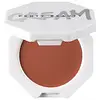What's inside
What's inside
 Key Ingredients
Key Ingredients

 Benefits
Benefits

 Concerns
Concerns

 Ingredients Side-by-side
Ingredients Side-by-side

Octyldodecanol
EmollientIsononyl Isononanoate
EmollientDicalcium Phosphate
AbrasiveSynthetic Fluorphlogopite
Caprylic/Capric Triglyceride
MaskingPentaerythrityl Tetraisostearate
EmollientSynthetic Wax
AbrasiveBis-Diglyceryl Polyacyladipate-2
EmollientPolyethylene
AbrasiveSilica Silylate
EmollientNylon-12
Candelilla Cera
EmollientDisteardimonium Hectorite
StabilisingTocopheryl Acetate
AntioxidantPentaerythrityl Tetra-Di-T-Butyl Hydroxyhydrocinnamate
AntioxidantTalc
AbrasiveTin Oxide
AbrasiveBHT
AntioxidantCI 45410
Cosmetic ColorantCI 42090
Cosmetic ColorantCI 15850
Cosmetic ColorantCI 77891
Cosmetic ColorantCI 77491
Cosmetic ColorantOctyldodecanol, Isononyl Isononanoate, Dicalcium Phosphate, Synthetic Fluorphlogopite, Caprylic/Capric Triglyceride, Pentaerythrityl Tetraisostearate, Synthetic Wax, Bis-Diglyceryl Polyacyladipate-2, Polyethylene, Silica Silylate, Nylon-12, Candelilla Cera, Disteardimonium Hectorite, Tocopheryl Acetate, Pentaerythrityl Tetra-Di-T-Butyl Hydroxyhydrocinnamate, Talc, Tin Oxide, BHT, CI 45410, CI 42090, CI 15850, CI 77891, CI 77491
Caprylic/Capric Triglyceride
MaskingOctyldodecanol
EmollientTridecyl Trimellitate
EmollientPentaerythrityl Tetraisostearate
EmollientCaprylic/Capric/Myristic/Stearic Triglyceride
EmollientSilica
AbrasiveDiisostearyl Malate
EmollientPolyhydroxystearic Acid
EmulsifyingSynthetic Fluorphlogopite
C10-18 Triglycerides
EmollientStearalkonium Hectorite
Gel FormingSorbitan Olivate
EmulsifyingPolyglyceryl-2 Triisostearate
EmulsifyingSynthetic Wax
AbrasivePolyethylene
AbrasiveButyrospermum Parkii Butter
Skin ConditioningMangifera Indica Seed Butter
Skin ConditioningShorea Stenoptera Seed Butter
EmollientAcetyl Hexapeptide-8
HumectantCeramide NP
Skin ConditioningTocopherol
AntioxidantHydrolyzed Sodium Hyaluronate
Skin ConditioningLimnanthes Alba Seed Oil
Skin ConditioningPropylene Carbonate
SolventSilica Silylate
EmollientLecithin
EmollientPolyglyceryl-3 Polyricinoleate
EmulsifyingCetyl Ethylhexanoate
EmollientIsostearic Acid
CleansingGlyceryl Behenate
EmollientPolyglyceryl-3 Laurate
EmulsifyingWater
Skin ConditioningMethyl Glucose Sesquistearate
EmollientTitanium Dioxide
Cosmetic ColorantCI 77491
Cosmetic ColorantCI 77492
Cosmetic ColorantCI 77499
Cosmetic ColorantCI 42090
Cosmetic ColorantCI 15850
Cosmetic ColorantCI 15985
Cosmetic ColorantCI 45410
Cosmetic ColorantCI 19140
Cosmetic ColorantCaprylic/Capric Triglyceride, Octyldodecanol, Tridecyl Trimellitate, Pentaerythrityl Tetraisostearate, Caprylic/Capric/Myristic/Stearic Triglyceride, Silica, Diisostearyl Malate, Polyhydroxystearic Acid, Synthetic Fluorphlogopite, C10-18 Triglycerides, Stearalkonium Hectorite, Sorbitan Olivate, Polyglyceryl-2 Triisostearate, Synthetic Wax, Polyethylene, Butyrospermum Parkii Butter, Mangifera Indica Seed Butter, Shorea Stenoptera Seed Butter, Acetyl Hexapeptide-8, Ceramide NP, Tocopherol, Hydrolyzed Sodium Hyaluronate, Limnanthes Alba Seed Oil, Propylene Carbonate, Silica Silylate, Lecithin, Polyglyceryl-3 Polyricinoleate, Cetyl Ethylhexanoate, Isostearic Acid, Glyceryl Behenate, Polyglyceryl-3 Laurate, Water, Methyl Glucose Sesquistearate, Titanium Dioxide, CI 77491, CI 77492, CI 77499, CI 42090, CI 15850, CI 15985, CI 45410, CI 19140
 Reviews
Reviews

Ingredients Explained
These ingredients are found in both products.
Ingredients higher up in an ingredient list are typically present in a larger amount.
This ingredient is an emollient, solvent, and texture enhancer. It is considered a skin-softener by helping the skin prevent moisture loss.
It helps thicken a product's formula and makes it easier to spread by dissolving clumping compounds.
Caprylic Triglyceride is made by combining glycerin with coconut oil, forming a clear liquid.
While there is an assumption Caprylic Triglyceride can clog pores due to it being derived from coconut oil, there is no research supporting this.
Learn more about Caprylic/Capric TriglycerideCi 15850 is the pigment color red. It is an azo dye and created synthetically.
Azo dyes need to be thoroughly purified before use. This allows them to be more stable and longer-lasting.
This ingredient is common in foundations, lipsticks, and blushes. This color is described as brown/orangey red.
It has many secondary names such as Red 6 and Red 7. According to a manufacturer, Red 6 usually contains aluminum.
Learn more about CI 15850Ci 42090 is a synthetic dye created from petroleum. It is used to give a bright blue color to cosmetics, medicine, and food.
CI 45410 is a synthetic red-pigment and dye.
It often goes by both Red 28 or Red 27; manufacturers label both ingredients as CI 45410.
This dye is commonly found in makeup because it imparts a vivid color. Some types of this dye change color based on pH level and interaction with moisture:
Your skin has a natural pH of around 4.5 - 5.5.
According to the FDA, CI 45410 is not permitted for use in eye products.
Red 27 is a flourescein dye and commonly used as a fluorescent tracer in medicine.
Learn more about CI 45410Ci 77491 is also hydrated iron III oxide. It's sole purpose is to give a red/pink hue to products.
Iron III oxides are classified as inorganic chemicals for coloring.
Synthetically created Ci 77491 is considered safer than those naturally found. This is because the synthetically created version may contain less impurities. Iron oxides are generally non-toxic and non-allergenic.
Learn more about CI 77491Octyldodecanol is a fatty alcohol. It is primarily used to enhance the texture of products.
As an emulsifier, Octyldodecanol helps prevent the oils and waters from separating. It also prevents ingredients from creating foam when shaken.
Octyldodecanol is created by reducing fatty acid to an alcohol.
Due to its high molecular weight, it does not get absorbed into the skin.
Learn more about OctyldodecanolPentaerythrityl Tetraisostearate is derived from isostearic acid. It is an emollient and emulsifier.
The highest concentration of this ingredient is found in lipsticks.
This ingredient is minimally water soluble and may not be Malassezia folliculitis, or fungal-acne safe.
Learn more about Pentaerythrityl TetraisostearatePolyethylene is a synthetic ingredient that helps the skin retain moisture. It is a polymer.
It is also typically used within product formulations to help bind solid ingredients together and thicken oil-based ingredients. When added to balms and emulsions, it helps increase the melting point temperature.
Silica Silylate is a siloxane polymer, meaning it is made up of silicon and oxygen atoms. It is not soluble in water.
This ingredient is a white powder with oil-absorbing, emollient, and anticaking properties.
Synthetic Fluorphlogopite is the synthethic version of mica. It consists of fluorine, aluminum and silicate.
Synthetic Fluorphlogopite is used to add volume to products.
It is considered non-irritating on the skin.
Learn more about Synthetic FluorphlogopiteSynthetic Wax is created from fossil fuels such as natural gas. It is used to enhance texture, adjust pH, and as an occlusive.
It may also be used as an abrasive ingredient to exfoliate the skin.
Synthetic Wax may not be fungal acne safe.
Learn more about Synthetic Wax